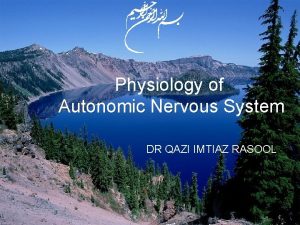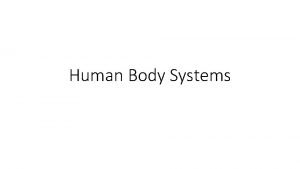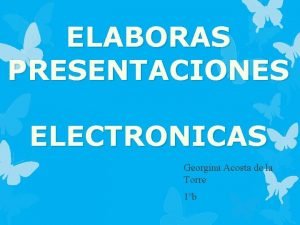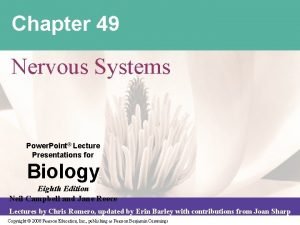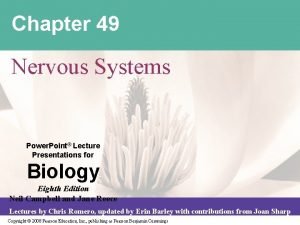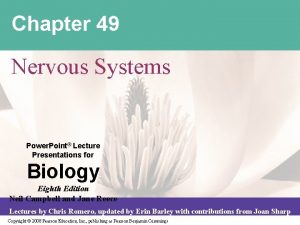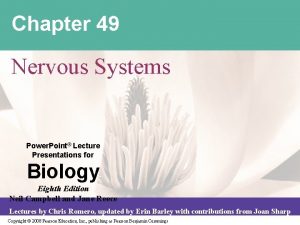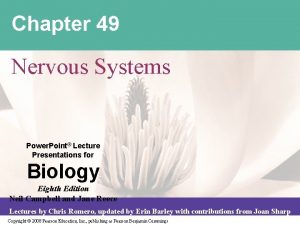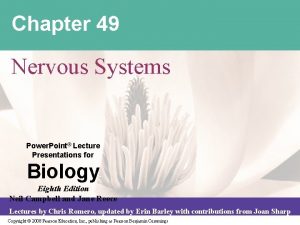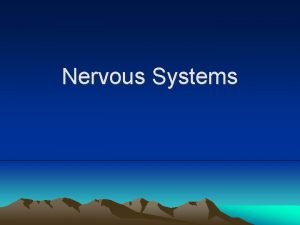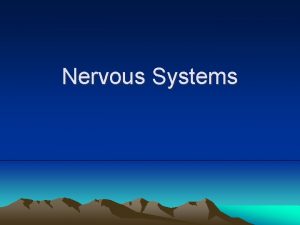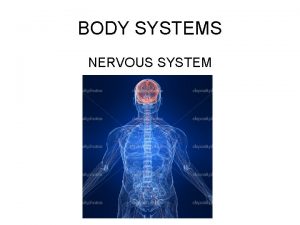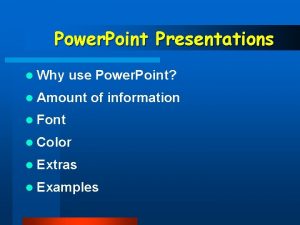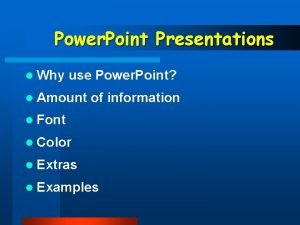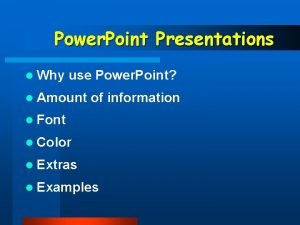Chapter 49 Nervous Systems Power Point Lecture Presentations





























- Slides: 29

Chapter 49 Nervous Systems Power. Point® Lecture Presentations for Biology Eighth Edition Neil Campbell and Jane Reece Lectures by Chris Romero, updated by Erin Barley with contributions from Joan Sharp Copyright © 2008 Pearson Education, Inc. , publishing as Pearson Benjamin Cummings

Animal Nervous Systems • Nervous systems consist of circuits of neurons and supporting cells • All animals except sponges – Have some type of nervous system • What distinguishes the nervous systems of different animal groups – Is how the neurons are organized into circuits Copyright © 2008 Pearson Education, Inc. , publishing as Pearson Benjamin Cummings

Fig. 49 -2 – Nervous System Organization Eyespot Brain Radial nerve Nerve cords Nerve ring Transverse nerve Nerve net Brain Ventral nerve cord Segmental ganglia (a) Hydra (cnidarian) (b) Sea star (echinoderm) (c) Planarian (flatworm) (d) Leech (annelid) Brain Ventral nerve cord Anterior nerve ring Ganglia Brain Longitudinal nerve cords Ganglia (f) Chiton (mollusc) (g) Squid (mollusc) Spinal cord (dorsal nerve cord) Sensory ganglia Segmental ganglia (e) Insect (arthropod) (h) Salamander (vertebrate)

Fig. 49 -4 Central nervous system (CNS) Brain Spinal cord Peripheral nervous system (PNS) Cranial nerves Ganglia outside CNS Spinal nerves

Organization of the Vertebrate Nervous System • The spinal cord conveys information from the brain to the PNS • The spinal cord also produces reflexes independently of the brain • A reflex is the body’s automatic response to a stimulus – For example, a doctor uses a mallet to trigger a knee-jerk reflex Copyright © 2008 Pearson Education, Inc. , publishing as Pearson Benjamin Cummings

Three Stages of Information Processing • Nervous systems process information in three stages: 1. sensory input; 2. integration; 3. motor output Sensory input Integration Sensor Motor output Figure 48. 3 Effector Peripheral nervous system (PNS) Copyright © 2008 Pearson Education, Inc. , publishing as Pearson Benjamin Cummings Central nervous system (CNS)

Three Stages of Information Processing http: //www. sumanasinc. com/webcontent/animations/content/reflexarcs. html 2 Sensors detect a sudden stretch in the quadriceps. 3 Sensory neurons convey the information to the spinal cord. Cell body of sensory neuron in dorsal root ganglion 4 The sensory neurons communicate with motor neurons that supply the quadriceps. The motor neurons convey signals to the quadriceps, causing it to contract and jerking the lower leg forward. Gray matter 5 Sensory neurons from the quadriceps also communicate with interneurons in the spinal cord. Quadriceps muscle White matter Hamstring muscle 6 Spinal cord (cross section) Sensory neuron Figure 48. 4 1 The reflex is initiated by tapping the tendon connected to the quadriceps (extensor) muscle. Copyright © 2008 Pearson Education, Inc. , publishing as Pearson Benjamin Cummings Motor neuron Interneuron The interneurons inhibit motor neurons that supply the hamstring (flexor) muscle. This inhibition prevents the hamstring from contracting, which would resist the action of the quadriceps.

Organization of the Vertebrate Nervous System • The central canal of the spinal cord and the ventricles of the brain are hollow and filled with cerebrospinal fluid • The cerebrospinal fluid is filtered from blood and functions to cushion the brain and spinal cord • The brain and spinal cord contain – Gray matter, which consists of neuron cell bodies, dendrites, and unmyelinated axons – White matter, which consists of bundles of myelinated axons Copyright © 2008 Pearson Education, Inc. , publishing as Pearson Benjamin Cummings

Fig. 49 -6 PNS CNS VENTRICLE Neuron Astrocyte Ependymal cell Oligodendrocyte Schwann cells Microglial cell Capillary 50 µm (a) Glia in vertebrates (b) Astrocytes (LM)

Fig. 49 -7 -2 PNS Afferent (sensory) neurons Efferent neurons Autonomic nervous system Motor system Locomotion Sympathetic division Parasympathetic division Hormone Gas exchange Circulation action Hearing Enteric division Digestion

Fig. 49 -8 Sympathetic division Parasympathetic division Action on target organs: Constricts pupil of eye Dilates pupil of eye Stimulates salivary gland secretion Inhibits salivary gland secretion Constricts bronchi in lungs Cervical Sympathetic ganglia Relaxes bronchi in lungs Slows heart Accelerates heart Stimulates activity of stomach and intestines Inhibits activity of stomach and intestines Thoracic Stimulates activity of pancreas Inhibits activity of pancreas Stimulates gallbladder Stimulates glucose release from liver; inhibits gallbladder Lumbar Stimulates adrenal medulla Promotes emptying of bladder Promotes erection of genitals Inhibits emptying of bladder Sacral Synapse Promotes ejaculation and vaginal contractions

Table 49 -1

Fig. 49 -UN 5 Cerebral cortex Cerebrum Forebrain Thalamus Hypothalamus Pituitary gland Midbrain Hindbrain Pons Medulla oblongata Cerebellum Spinal cord

Fig. 49 -UN 1

Fig. 49 -UN 2

Fig. 49 -UN 3

Fig. 49 -UN 4

Fig. 49 -13 Left cerebral hemisphere Right cerebral hemisphere Corpus callosum Thalamus Cerebral cortex Basal nuclei

Fig. 49 -15 Frontal lobe ens o tos So Mo Frontal association area ma tor cor ry tex cor tex Parietal lobe Speech Taste Speech Somatosensory association area Reading Hearing Smell Auditory association area Visual association area Vision Temporal lobe Occipital lobe

Fig. 49 -16 Parietal lobe Frontal lobe Jaw Tongue Pharynx Primary motor cortex Abdominal organs b um Lips Tee Gumtsh Jaw Genitals Primary somatosensory cortex Leg s er ng Th b Toes Face Hip Trunk Neck m r ar ow Elb Head e Upp m ar Fi nd Ha ist re Fo Knee Hip Trunk lder Shou ow Elb m ear For Wr nd Ha rs ge n Fi um Th Ey e No se Fa ce Li ps Nec k Bro w Eye

Fig. 49 -18 Thalamus Hypothalamus Prefrontal cortex Olfactory bulb Amygdala Hippocampus

Memory and Learning • Learning can occur when neurons make new connections or when the strength of existing neural connections changes • Short-term memory is accessed via the hippocampus • The hippocampus also plays a role in forming long-term memory, which is stored in the cerebral cortex Copyright © 2008 Pearson Education, Inc. , publishing as Pearson Benjamin Cummings

Concept 49. 5: Nervous System Disorders • Nervous system disorders can be explained in molecular terms • Disorders of the nervous system include schizophrenia, depression, Alzheimer’s disease, and Parkinson’s disease • Genetic and environmental factors contribute to diseases of the nervous system Copyright © 2008 Pearson Education, Inc. , publishing as Pearson Benjamin Cummings

Schizophrenia • About 1% of the world’s population suffers from schizophrenia • Schizophrenia is characterized by hallucinations, delusions, blunted emotions, and other symptoms • Available treatments focus on brain pathways that use dopamine as a neurotransmitter Copyright © 2008 Pearson Education, Inc. , publishing as Pearson Benjamin Cummings

Depression • Two broad forms of depressive illness are known: major depressive disorder and bipolar disorder • In major depressive disorder, patients have a persistent lack of interest or pleasure in most activities • Bipolar disorder is characterized by manic (highmood) and depressive (low-mood) phases • Treatments for these types of depression include drugs such as Prozac and lithium Copyright © 2008 Pearson Education, Inc. , publishing as Pearson Benjamin Cummings

Drug Addiction and the Brain Reward System • The brain’s reward system rewards motivation with pleasure • Some drugs are addictive because they increase activity of the brain’s reward system • These drugs include cocaine, amphetamine, heroin, alcohol, and tobacco • Drug addiction is characterized by compulsive consumption and an inability to control intake Copyright © 2008 Pearson Education, Inc. , publishing as Pearson Benjamin Cummings

Fig. 49 -22 Nicotine stimulates dopaminereleasing VTA neuron. Opium and heroin decrease activity of inhibitory neuron. Cocaine and amphetamines block removal of dopamine. Cerebral neuron of reward pathway Reward system response

Alzheimer’s Disease • Alzheimer’s disease is a mental deterioration characterized by confusion, memory loss, and other symptoms • Alzheimer’s disease is caused by the formation of neurofibrillary tangles and amyloid plaques in the brain • A successful treatment in humans may hinge on early detection of amyloid plaques • There is no cure for this disease though some drugs are effective at relieving symptoms Copyright © 2008 Pearson Education, Inc. , publishing as Pearson Benjamin Cummings

Parkinson’s Disease • Parkinson’s disease is a motor disorder caused by death of dopamine-secreting neurons in the midbrain • It is characterized by difficulty in initiating movements, muscle tremors, slowness of movement, and rigidity • There is no cure, although drugs and various other approaches are used to manage symptoms Copyright © 2008 Pearson Education, Inc. , publishing as Pearson Benjamin Cummings
 Slidetodoc
Slidetodoc Neural circuits the organization of neuronal pools
Neural circuits the organization of neuronal pools Nervous
Nervous Nerve cell processes
Nerve cell processes Chapter 14 lesson 3 the nervous system
Chapter 14 lesson 3 the nervous system 01:640:244 lecture notes - lecture 15: plat, idah, farad
01:640:244 lecture notes - lecture 15: plat, idah, farad Power triangle
Power triangle Powerbi in powerpoint
Powerbi in powerpoint Point point power
Point point power The body's speedy electrochemical communication network
The body's speedy electrochemical communication network Prevertebral ganglia
Prevertebral ganglia Nervous system chart
Nervous system chart Nervous interactions with other systems
Nervous interactions with other systems Operating system lecture notes
Operating system lecture notes Lecture sound systems
Lecture sound systems Lecture sound systems
Lecture sound systems Power system dynamics and stability lecture notes
Power system dynamics and stability lecture notes Zline 667-36
Zline 667-36 Power semiconductor devices lecture notes
Power semiconductor devices lecture notes Switch mode power supply lecture notes
Switch mode power supply lecture notes Power system dynamics and stability lecture notes
Power system dynamics and stability lecture notes Things fall apart customs
Things fall apart customs Craft of scientific presentations
Craft of scientific presentations Introduction to mental health awareness presentation
Introduction to mental health awareness presentation Bad slide examples
Bad slide examples To maintain audience interest in a multimedia presentation
To maintain audience interest in a multimedia presentation Desventajas de corel presentations
Desventajas de corel presentations -is not one of the purposes for giving oral presentations.
-is not one of the purposes for giving oral presentations. Verbal support examples
Verbal support examples Tok presentations
Tok presentations










